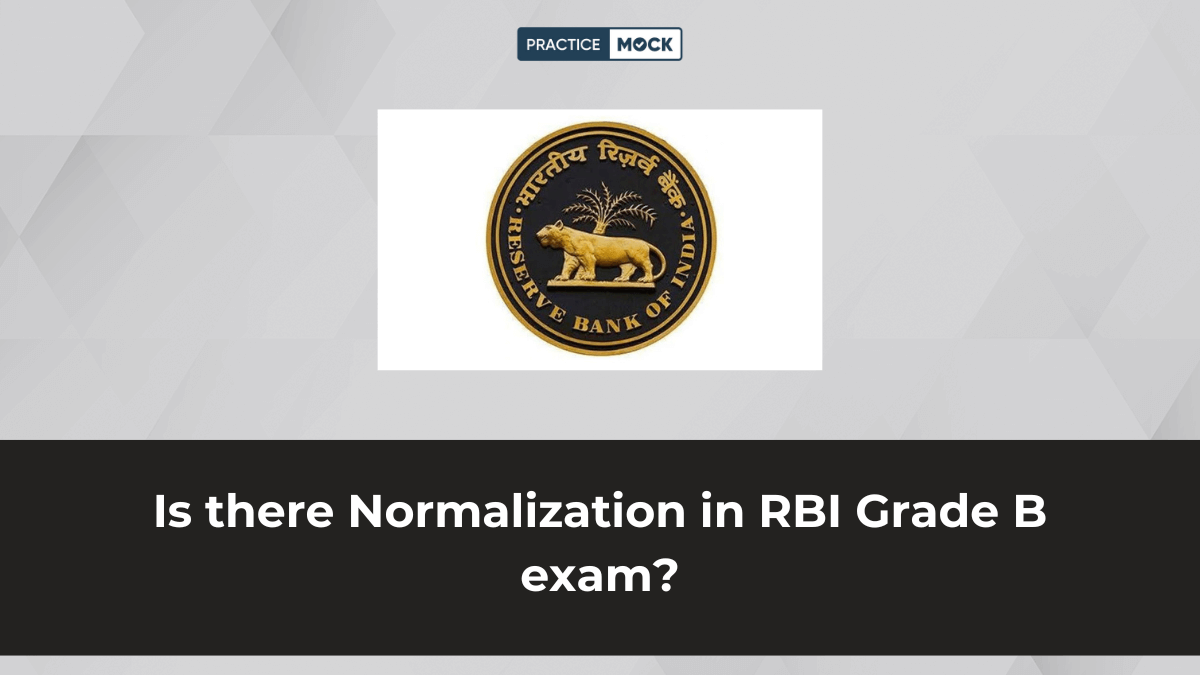Knowing about normalization is vital for RBI Grade B aspirants. It affects how scores are compared between different exam shifts. It’s a matter of importance, especially among aspirants appearing in different exam shifts. Because the RBI Grade B exam is conducted in different shifts, each shift’s difficulty level can be slightly different. Hearing this, many aspirants may feel that the evaluation process is not fair. In this blog, we’ll explore the concept of normalization, whether RBI uses it, how it works, and what impact it has on your results. Let’s understand whether your marks will be calculated under normalization and whether you need to keep this in mind while preparing.
What is Normalization?
Normalization is a statistical method that is used to adjust the scores of candidates based on the difficulty level of different shifts in the competitive exam. It makes sure that performance is judged fairly across all shifts. In short, it protects candidates from being unfairly impacted by tougher exam shifts.
Does RBI Grade B Exam Have Normalization?
Yes, and no. Because nobody knows whether it uses the same normalization as other competitive exams. But, it might be applied by the RBI, especially because this stage is conducted in multiple shifts across different centers. RBI might adopt normalization to level the playing field when shifts have slightly different levels of difficulty. On the other hand, the normalization is not used in the Phase 2 exam, because this Phase is generally conducted in a single shift for all candidates.
Normalization Formula: Practical Example of Normalization
Let’s say:
- Your shift was Shift 1, which was tougher than others.
- You scored 78 out of 100.
- Average score of Shift 1: 65
- Standard deviation of Shift 1: 10
Now compare that with:
- Average score of all shifts: 70
- Standard deviation of all shifts: 12
Using the normalization formula:
Step-by-step Normalization Example:
- Step 1: Raw Score Difference: 78 (Topper’s score) – 65 (Your score) = 13
- Step 2: Divide by Standard Deviation: 13 ÷ 10 = 1.3
- Step 3: Multiply by a Set Factor (Scaling factor): 1.3 × 12 = 15.6
- Step 4: Add the Base Score (mean or average): 15.6 + 70 = 85.6
So, your actual score (78) becomes 85.6 after normalization. This is a result of the higher difficulty in the exam shift you appeared in.
How Normalization Affects Your Final Marks?
Only the normalized marks are considered for shortlisting candidates for the Phase 2 exam. So, even if your raw marks are lower, a tougher shift might boost your normalized score. It is believed (not sure) that RBI follows a standard normalization method (used by most major recruiting bodies like IBPS and SSC), though RBI has not disclosed the exact formula.
What Should You Do?
You need not worry about the normalization process while preparing. Instead:
- Prepare smartly and pay attention to scoring as high as possible.
- Take RBI Grade B mock tests and get the real RBI Grade B exam experience and its difficulty in diffrent shifts.
NOTE: Keep in mind that normalization can work in your favour if your shift is tougher. But, as discussed above, it is not known whether RBI uses such normalization or not, because it hasn’t revealed any such method.
Takeaway
From the given discussion, you must have come to know that there is no confirmed information about whether the RBI uses the normalization method or not. Just many experts believe that it might be used. RBI has never officially disclosed this. But what is confirmed is that the RBI follows a shift-wise cutoff system. While many regulatory exams and banking exams like IBPS and SSC use normalization to balance the difficulty levels of different shifts. RBI follows a shift-wise cutoff system instead. This means that every shift of RBI, according to the difficulty level of its exam slot, has its own cutoff based on the difficulty of that particular slot. So, it’s better to focus on performing your best in your allotted shift instead of worrying about normalization. Attempt mock tests that match RBI’s level to boost your confidence, accuracy, and speed. Smart preparation, not speculation, is the key to success in RBI Grade B.
Join our unique Telegram group immediately to skyrocket your preparation for Regulatory exams via expert guidance, top tips, perfect feedback, and much more!
[ Click Here to join the PracticeMock Telegram Group! ]
[ Click Here to join the PracticeMock Telegram Discussion Group Link! ]
Related Blogs:
FAQs
RBI hasn’t declared whether it uses normalization in the Grade B exam. Though it is believed by many that it uses the method.
No, RBI uses separate cutoffs for each shift instead.
RBI maintains fairness by setting shift-wise cutoffs rather than adjusting scores.
Not always, which is why shift-specific cutoffs are applied.
No, shift-wise cutoffs balance difficulty variations fairly.
- Sign Up on Practicemock for Updated Current Affairs, Free Topic Tests and Free Mini Mocks
- Sign Up Here to Download Free Study Material
Free Mock Tests for the Upcoming Exams
- IBPS PO Free Mock Test
- RBI Grade B Free Mock Test
- IBPS SO Free Mock Test
- NABARD Grade A Free Mock Test
- SSC CGL Free Mock Test
- IBPS Clerk Free Mock Test
- IBPS RRB PO Free Mock Test
- IBPS RRB Clerk Free Mock Test
- RRB NTPC Free Mock Test
- SSC MTS Free Mock Test
- SSC Strenographer Free Mock Test
- GATE Mechanical Free Mock Test
- GATE Civil Free Mock Test
- RRB ALP Free Mock Test
- SSC CPO Free Mock Test
- AFCAT Free Mock Test
- SEBI Grade A Free Mock Test
- IFSCA Grade A Free Mock Test
- RRB JE Free Mock Test
- Free Banking Live Test
- Free SSC Live Test



